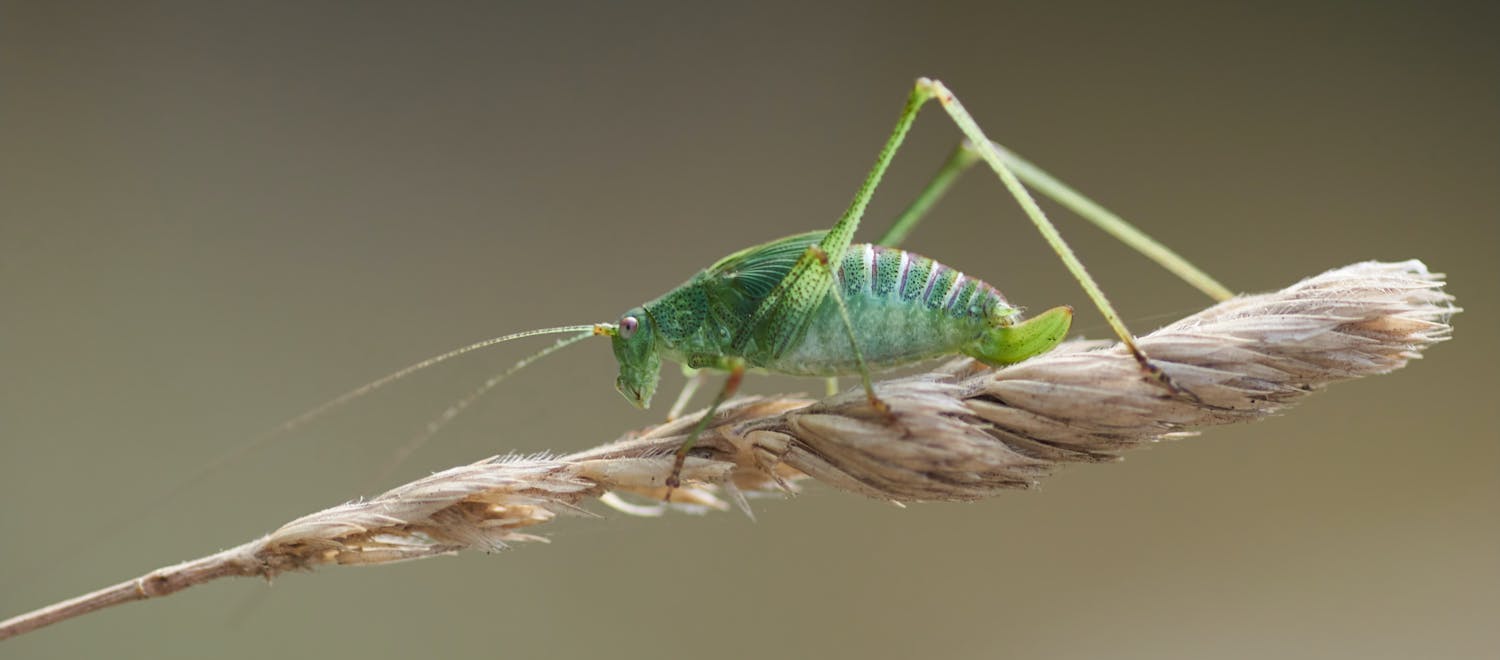On the Menu: Crickets
12 December 2020
4 min read

1. Cricket or grasshopper?
Can you spot the difference? Even though the two are very often mixed up, the difference between is actually quite obvious once you know it. Both have those huge back legs they use to jump, but that's the biggest visual aspect they share. In general, the cricket is smaller than the grasshopper which is easy to spot when you see both, but a little harder on an individual photo [1]. The easiest thing to distinguish the two is that crickets have long antennae that are almost as long as the cricket itself, while the antennae of grasshoppers are relatively short.
2. Eats about everything.
Whereas the grasshopper is a herbivore, crickets don't really do diets. Even though most of the crickets have a preference towards food that does not put up a fight - like fresh and tasty plant material, fruits and veggies - they also eat other animals and are thus omnivores. And while the majority of crickets are primarily herbivores, there are also species of crickets that are primarily carnivores and eat plants only when necessary [2].
Like humans, crickets also like fresh food better than stuff that isn't. However, many also have the title scavengers because, in case the need arises, they are also okay eating decaying plants, fungi, and organic remains from injured or dead animals. Worst comes to worst, and the foodstocks are at an all-time low, crickets can even resort to eating one another, making them not only scavengers but also cannibals.
3. A lucky charm and a cagefighter in China...
Crickets have a rich and various history in Chinese culture. The first stories dating back more than 2500 years tell crickets were kept as symbols of luck and put near the beds of ladies in the palace to listen to the songs at night [5]. 1500 years later, cricket fighting has become about as popular as football is right now. Certain cricket species were carefully selected, got their own beautifully crafted cages out of bamboo, and were even given a particular diet and training to be optimally prepared for fights and championships. It's safe to say that cricket fighting was (and still is) serious business!
4. ...and a delicacy in other countries
And that is not where it ends for the cricket and its history. In many other countries of the world, the cricket is considered a delicacy [3]. Thailand, most notably, has a number of snacks in which the cricket plays the main role. Jing Leed is one of the most common snacks of the country and is prepared with fried crickets. The crickets are briefly fried in a wok, seasoned with sauce and some Thai pepper powder [4]. Best served on its own or paired with some Thai beer!
5. Efficient in many ways
It might be hard to believe after just reading that crickets had a rich history of fighting - even though it barely happened that crickets got seriously injured during these fights - but a cricket usually weighs basically nothing. The bulk of all cricket species are lighter than your average paperclip: where a paperclip weights about one gram, a cricket weighs between 0.2 and 0.8 grams.
But packed into that little amount of body mass is their incredible jumping strenght and apparently the strength for some brawling every now and then! And for this strength and body composition, the cricket is also 10 times more efficient when it comes to how much food it needs compared to cattle [6] - making it one of the potentially perfect future sources of food.
Nutritional values
Crickets are not only a very efficient source of protein, the protein content is also pretty amazing. If you buy 100 grams of freeze-dried crickets (from for example Insec2Eat or Catch-your-bug), you approximately end up with the following nutritional values:
- 460 calories
- 65 grams of protein -> 56% of the calories
- 1 gram of carbs -> 1% of the calories
- 5 grams of fiber
- 22 grams of fat -> 43% of the calories
- Cricket. Accessed December 1st, 2020 at https://www.terro.com/crickets
- Chris Miksen. What Crickets eat in the Wild. Accessed December 1st, 2020 at https://animals.mom.com/crickets-eat-wild-6275.html
- Assured Environments (June 28th, 2017). The Top 10 Weirdest Facts About Crickets. Accessed December 1st, 2020 at https://www.assuredenvironments.com/blog/post/the-top-10-weirdest-facts-about-crickets
- ImportFood. THAI INSECTS - POPULAR SNACK FOOD IN THAILAND. Accessed December 1st, 2020 at https://importfood.com/features/thai-cooking-features/item/thai-insects-popular-snack-food-in-thailand
- ChinaTravel. Chinese Cricket Culture. Accessed December 2nd, 2020 at https://www.chinatravel.com/facts/chinese-cricket-culture.htm
- Matt Simon (July 8th, 2016). I've Been to the Future. It Tastes Like Crickets. Accessed December 2nd, 2020 at https://www.wired.com/2016/07/ive-future-tastes-like-crickets/
